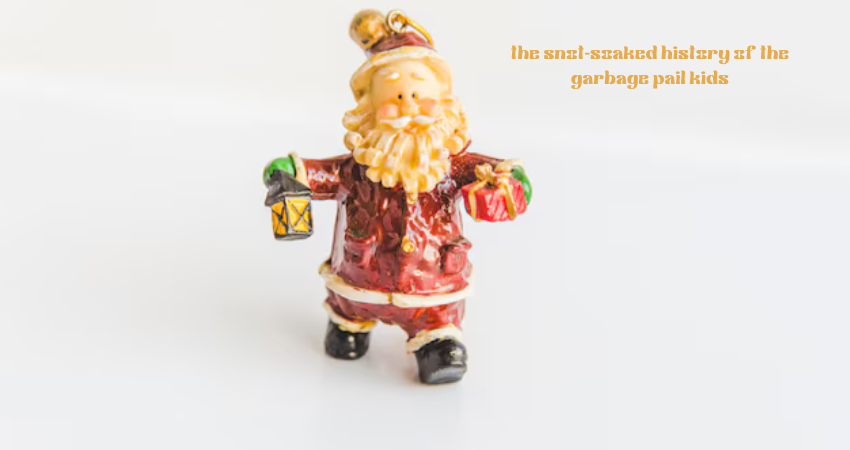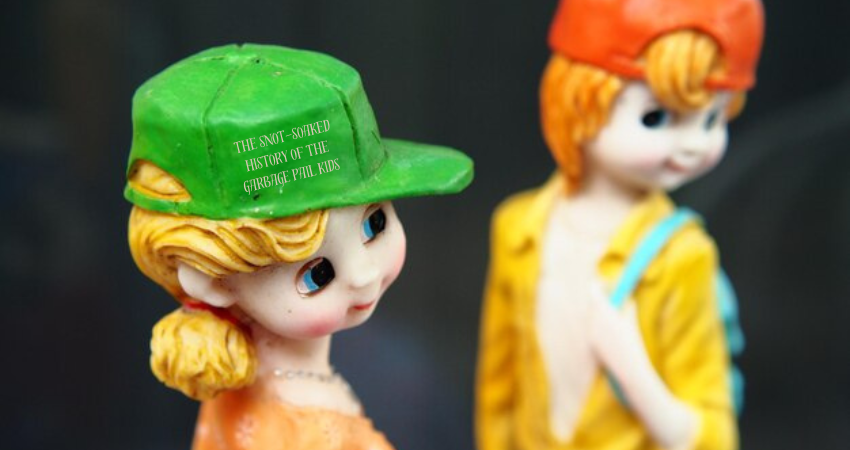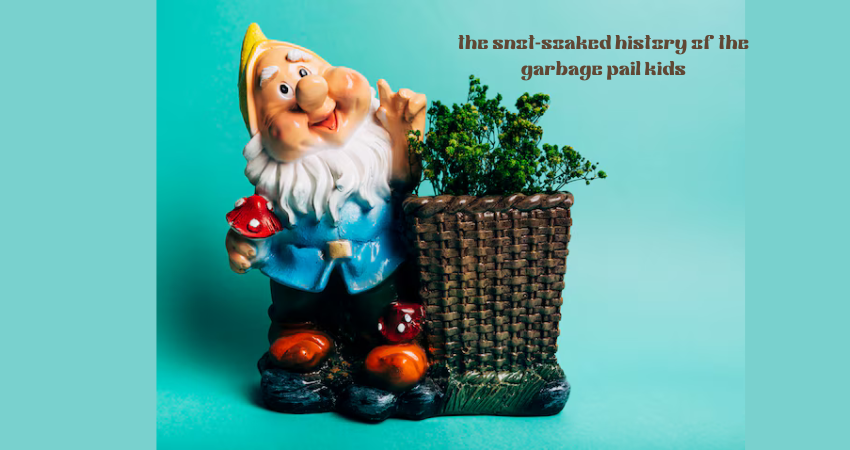Somewhere in the crowded aisles of a 1980s supermarket, wedged between the vibrant packaging of cereal boxes and the sugary allure of penny candy, was a curious little box of trading cards. Tiny and unassuming, it bore a peculiar name that whispered rebellion: the snot-soaked history of the garbage pail kids. Beneath its crinkled wrapper lay not just cards but an entire world—a bizarre, grotesque, and brilliant universe of sticky humor and biting social commentary.
This is the tale of how these sticky, snot-soaked antiheroes conquered hearts and horrified sensibilities, leaving behind a cultural legacy that’s as pungent as it is profound.
A Rotten Beginning: The Birth of the Garbage Pail Kids
In the mid-1980s, Topps, a titan of the trading card industry, faced a peculiar conundrum. Known primarily for their baseball cards, Topps had also enjoyed success with whimsical novelties like Wacky Packages, satirical cards that spoofed popular consumer products. Yet, by the time the decade rolled around, the cultural zeitgeist demanded something more outrageous, something even weirder.
Enter Art Spiegelman and Mark Newgarden, two maverick cartoonists working within Topps’ creative laboratory. Art Spiegelman, already a celebrated underground comics creator, would later gain acclaim for Maus, his Pulitzer Prize-winning graphic novel. For now, though, he and Newgarden were brainstorming something cruder, something that would tickle and terrify in equal measure.
Their muse? The Cabbage Patch Kids.
Yes, those cherubic, dimple-cheeked dolls that were setting the toy aisles on fire. Topps wanted to riff on their popularity while subverting their saccharine charm. Instead of wide-eyed innocence, the cards would revel in chaos. Snot, slime, vomit—nothing was off-limits.
From this deliciously demented vision, the Garbage Pail Kids were born.

Stickers with an Edge: The Artistic Alchemy
Each Garbage Pail Kid card was a work of art—literally. The series thrived on its painstakingly detailed illustrations, courtesy of artists like John Pound, Tom Bunk, and James Warhola. These weren’t just hastily drawn cartoons. No, these were masterfully painted portraits of mayhem.
Characters like Adam Bomb—a child with a mushroom cloud erupting from his head—or Leaky Lindsay, whose incessantly dripping nose was a symphony of slime, were rendered with a surreal, almost painterly quality. The art was grotesque yet oddly beautiful, captivating kids who found glee in its forbidden feel.
And the names! Oh, the names! Every character was christened with a delightfully gross pun or rhyme, from Barfin’ Barbara to Up Chuck. Each card was a double-edged joke, sharp enough to slice through polite society’s expectations.
Cultural Controversy: From Collectors to Crusaders
But the Garbage Pail Kids were more than mere trading cards. They were a cultural earthquake, shaking the fragile morality of mid-1980s America. Parents and educators were aghast at the cards’ irreverent humor. How could such vile images find their way into the innocent hands of children?
This moral panic only fueled their popularity. For kids, the Garbage Pail Kids weren’t just funny—they were a rebellion. In a world of rigid rules and sanitized cartoons, these cards were a rare space where the grotesque could thrive. They were cool. They were dangerous.
But not everyone was amused. Lawsuits loomed on the horizon. The creators of the Cabbage Patch Kids, Coleco, slapped Topps with a trademark infringement suit in 1986. The cards, they argued, were too close for comfort. After a grueling legal battle, Topps was forced to tweak the Garbage Pail Kids’ logo and design. The series survived, but the lawsuit marked the beginning of an uphill battle.
The Television Misfire
Inevitably, Hollywood came knocking. In 1987, a live-action the snot-soaked history of the garbage pail kids was released, a bizarre and ill-conceived attempt to bring the cards to life. What should have been an ode to the cards’ anarchic spirit turned out to be a grotesque misstep, plagued by creepy animatronic puppets and a nonsensical plot.
Critics eviscerated the film, labeling it one of the worst movies ever made. Fans of the cards were equally disillusioned, and the movie’s failure seemed to cast a shadow over the franchise.
The Decline and Fall
By the late 1980s, the Garbage Pail Kids were struggling to stay relevant. The lawsuits, combined with increasing pushback from parents and schools, chipped away at their ubiquity. The cards, once a playground phenomenon, began to disappear from store shelves. By 1988, the original series had ended, leaving behind a trail of snotty nostalgia.
A Resurrected Legacy
But like any good antihero, the Garbage Pail Kids refused to die. The 2000s saw a wave of renewed interest, fueled by nostalgia and a cultural climate that embraced the weird and the wacky. Topps began releasing new series of cards, updating the humor while staying true to their snot-soaked roots.
Collectors and fans, now adults, rediscovered their childhood obsession. The Garbage Pail Kids became a beloved relic of a bygone era, celebrated for their unapologetic weirdness.
Why the Garbage Pail Kids Matter
At first glance, the Garbage Pail Kids might seem like lowbrow humor, a relic of adolescent giggles. But dig deeper, and their significance becomes clear. They were a satire of consumer culture, a critique of perfection, and a celebration of the grotesque.
In a world obsessed with neatness and order, the Garbage Pail Kids reveled in chaos. They taught us that it’s okay to be messy, to laugh at the absurd, and to embrace the imperfect.

FAQs
1. Who created the Garbage Pail Kids?
The Garbage Pail Kids were created by Topps Company artists Art Spiegelman, Mark Newgarden, and a talented team of illustrators like John Pound.
2. What inspired the Garbage Pail Kids?
The cards were a parody of the immensely popular Cabbage Patch Kids dolls, designed to mock their overly cute and commercialized image.
3. Why were the Garbage Pail Kids controversial?
The cards’ grotesque humor and often crude depictions shocked parents and educators, sparking debates about their appropriateness for children.
4. How many original Garbage Pail Kids series were there?
The original series ran from 1985 to 1988, spanning 15 series and over 600 unique characters.
5. Are Garbage Pail Kids still being produced?
Yes, Topps continues to release new Garbage Pail Kids series, appealing to both nostalgic fans and new generations.
6. What was the impact of the Garbage Pail Kids on pop culture?
The Garbage Pail Kids left a lasting legacy as icons of rebellion, humor, and artistic innovation, influencing everything from comics to collectibles.
Conclusion
The snot-soaked history of the garbage pail kids remain an enduring symbol of the weird, the rebellious, and the downright gross. From their humble beginnings as trading cards to their cultural resurgence, they’ve proven that sometimes, the most beautiful things emerge from the messiest places.
So here’s to Adam Bomb, Leaky Lindsay, and the rest of the gang. Long may they reign in their snot-soaked, gloriously grotesque kingdom.


